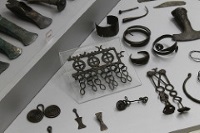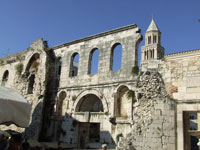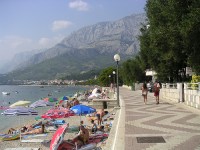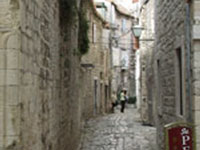
Founded in 1820, the Archaeological Museum in Split is the oldest museum in Croatia. Its displays include artefacts from prehistoric times, the Greek colonial period, and from the Roman, early Christian, and Medieval ages.Most of the relics found in excavations of the Roman city of Salona are displayed here, and there is an interesting collection of submarine archaeology. The museum also contains a large collection of antique coins and a prominent library. Outside the museum there is a lovely garden with a covered walkway and a number of statues on display, which makes for a good opportunity to wander a bit and take some photographs.Those who have smartphones can make use of the free wifi audio guide, which is informative and enhances the experience. Although this museum is not extensive, it remains very interesting and a great place to get familiar with Croatian history.
Address : Zrinsko-Frankopanska 25
Website : www.mdc.hr/split-arheoloski/eng/index.html
Brac's main claim to fame is the strip of beach near the resort of Bol that stretches out like a finger into the sea, featuring on almost all Croatian tourist brochures. Brac is the largest of the central Dalmatian group of islands and its major agricultural products are wine, olive oil, and fruit. The island is also known for its exported white stone, which was even used to build Washington DC's White House.Bol and Supetar are the two main resorts on Brac, with attractive old towns and a laidback charm. Bol is the windsurfing capital of Croatia, and Brac is a great destination for a number of watersports. The rest of the island boasts numerous villages and dramatic coastal scenery.Like much of Croatia, the beaches on Brac Island are mainly rocky, boasting stunningly clear blue water and calm seas. If you are desperate to find a sandy beach head down to Lovrecina, which has its own beach bar and restaurant and is a lovely spot to spend the day. Brac is generally less crowded than Split and other popular areas on Croatia's mainland, but can get very busy during the peak summer months.
Website : www.bracinfo.com

Roman Emperor Diocletian, having abdicated his throne in AD 305, decided to spend the last years of his life in Dalmatia and built a palace for that purpose on the bay of Aspalathos, on the south side of a peninsula extending into the Adriatic Sea.The spot he chose is now the very heart of the city of Split and the palace is still one of the city's main tourist attractions. The building and the entire historic Split inner city area around it have been declared a UNESCO World Heritage Site.Within the palace walls are a network of narrow cobblestone alleyways that house a mixture of residential apartments, modern shops, cafes and restaurants, ancient Roman relics, and a magnificent cathedral.The palace is interesting in that it was designed to combine a luxurious residence with the defences of a military camp, having towers and fortifications on its landward sides with three monumental gates.Originally situated on the water, the palace is now fronted by the city's popular waterfront promenade and faces onto the harbour. The buildings are made from local white limestone, quarried on the nearby island of Brac.
Off the coast of Split, just 15 nautical miles (24km) from Baska Voda and accessible by ferry, is the island of Hvar, which abounds with Romanesque and Renaissance buildings and a true Mediterranean atmosphere.Hvar has been populated since prehistoric times, with archaeologists finding evidence of life on the island dating back to 3500 BC. The island is noted for its fertile soil and was the site of the world's first parcelling out of arable land by the ancient Greeks, who farmed here.It is now mainly a wine-growing area, with the island's main towns of Vrboska and Jelsa famed for their Dalmatian vintages. Hvar is dotted with picturesque villages, many of which remain fairly untouched by time and tourism, and are well worth a visit for a glimpse into rural island life in Croatia.Must-see attractions in Hvar include the incredible Hvar Fortress which can't be missed by history buffs and anybody who appreciates a great view. It is a bit of a climb to get to the old fortress but from the site you can see the whole town and harbour. No visit to Hvar would be complete without a visit to Dubovica Beach, which is often delightfully free of the usual crowds.
Website : www.hvar.hr

About 30 miles (47km) south of Split is the popular resort town of Makarska, with its cobblestoned streets and natural harbour nestled in the shadow of Mount Biokovo and fringed with the two green peninsulas of Osejava and St Peter.This beautiful spot offers secluded beaches washed by an azure sea and lies at the heart of the Makarska Riviera, which is characterised by pine forests and a string of white pebble beaches. Makarska was an important trading port throught its history, which spans occupation by the Venetians, Turks, French and Austrians, all of whom left a taste of their culture and tradition behind.The town boasts a world-renowned collection of sea shells, a Franciscan monastery dating from the 16th century, a Venetian fountain, and several churches and Baroque palaces. However, its main attraction is its splendid natural beauty.The main tourist area of Makarska is lined with fashionable boutiques, cafes, and bars, all a stone's throw away from the yachts and catamarans docked in the harbour. Popular photo spots include a few beautiful churches and cathedrals dating back to the 13th century, as well as monuments dedicated to Friar Andrija Kaèiæ Miošiæ and Napoleon Bonaparte.

Sibenik is an historic town, located in central Dalmatia. A notable feature about the town's history is the number of civilizations which have laid claim to the territory: Between the 11th and 12th centuries, Sibenik was claimed by Venice, Byzantium, Hungary, and the Kingdom of Bosnia.After the First World War, Italy briefly claimed Sibenik, and during World War Two it was occupied by the Germans and the Italians. As one might imagine, the town is the product of diverse influences and has a rich cultural heritage.Sibenik is home to the crowning glory of the Dalmatian Coast: the Cathedral of St Jacob. The cathedral was the masterpiece of sculptor Juraj Dalmatinac and is reputedly the largest church in the world to be built entirely from stone.It is unusual for its 71 stone heads on the exterior walls, a beautiful baptistery, the domed roof complex, and various works of art in the interior of the building. The city also makes a good base from which to visit the nearby Krka National Park.

Trakoscan is a legendary 13th-century Gothic castle that was home to various influential families for centuries before finally falling into abandoned disrepair in the second half of the 18th century, when it belonged to the Draskovic family.In the 1950s, the castle was taken over by the state and turned into a living museum, reconstructing life in a medieval castle. Visitors can explore four levels, including the dungeon, and finish their tour with a stroll through the surrounding parklands.Trakoscan Castle is a spectacular journey for the imagination as it feels so authentic. Guests can wander with freedom through the stone corridors, up and down the winding staircases, and into the various rooms. It is also a great attraction for the younger children as the castle, lake, and forest settings transport the little ones to a fairytale world.The castle features original artefacts from its history, including furniture and weaponry, and displays are informative and well laid out. As wandering through the castle and its beautiful grounds can be somewhat tiring, visitors often stop for a break at the restaurant by the lake.

Travel Guide powered by Word Travels, copyright © 2023 Globe Media Ltd. By its very nature information in this travel guide is subject to change at short notice and travellers are urged to verify information on which they're relying with the relevant authorities. Neither Globe Media Ltd nor Travel Vogue can accept any responsibility for any loss or inconvenience to any person as a result of information contained above.